
- Permbajtja
- prev
- next
- prev
- next
Milan Design Week started in 1961 with a furniture fair called Salone del Mobile at Rho Fiera fairground. Since then, over the last sixty years, the yearly furniture fair has become the biggest one globally. Milan Design Week attracts around 500,000 visitors from all over the world each year. It's where designers, architects, and people in the design industry come to see the newest trends and ideas.
In the vibrant creativity of Milan Design Week 2024, innovation and creativity intertwine to shape the future of design. Among the myriad exhibitions and installations that grace this renowned event, eight stand out as paragons of ingenuity and inspiration. From architectural marvels to immersive experiences, each installation offers a unique glimpse into the evolving landscape of contemporary design. Join us as we embark on a journey through the top eight installations that captivated audiences and sparked conversations, illuminating the intersection of art, technology, and culture.
MAD Architects - ‘Amazing Walk’
MAD Architects, in partnership with Amazon, introduces the ‘Amazing Walk’ exhibit for Milan Design Week 2024 at FuoriSalone 2024, showcased within the INTERNI Cross Vision event exhibition. Running from April 15th to 28th at the Cortile della Farmacia dell’Università degli Studi di Milano, the installation showcases various home décor and design items available on Amazon.it.
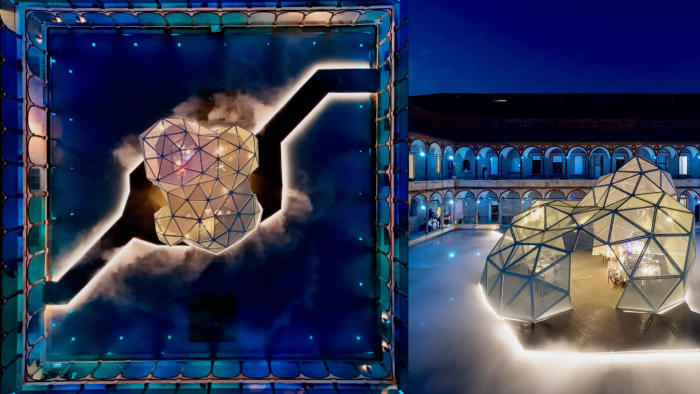
The ‘Amazing Walk’ installation invites attendees to embark on a sensory adventure in a distinctive environment, featuring a geometric mountain-like structure reflecting on water. Visitors can traverse a suspended pathway over the water, symbolizing their exploration of products. As they journey through the installation, visitors will encounter an immersive experience, discovering a diverse array of home furnishings, lighting solutions, smart home gadgets, and technological accessories, catering to various budgets.
Design Space AlUla - CLOUD, Studio Sabine Marcelis
During Milan Design Week 2024, Design Space AlUla from Saudi Arabia showcases a glimpse of the ancient oasis city’s rich natural and cultural heritage in Brera, the historical heart of Milan’s design scene. Curated by Sabine Marcelis and CLOUD, the exhibition presents a collection of furniture pieces and accessories, such as modular seating arrangements and biodegradable pots, engaging with the Fuorisalone theme of Materia Natura. Together, they delve into material expressions and traditional craftsmanship, offering reinterpretations of the region’s biodiversity, expansive desert landscapes, and cultural traditions from diverse perspectives.
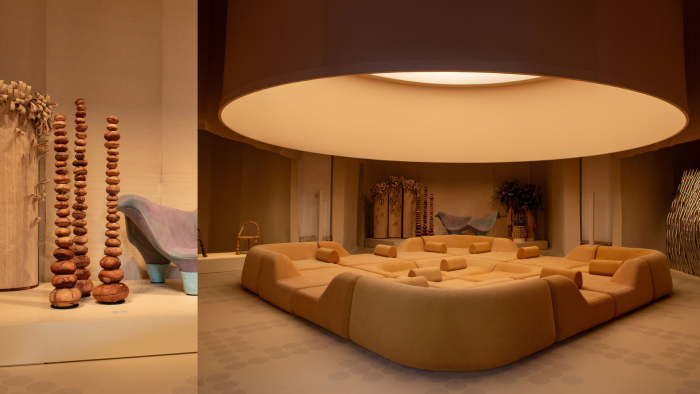
Featured works include The Magical Pillars by Dr. Zahrah Alghamdi, which recreates native rock formations in leather; TECHNOCrafts’ 3D printed Living Pots; and TAKK’s seating system, crafted from clay and naturally dyed fabric to evoke the undulating dunes of Saudi Arabia’s desert. The exhibition space itself revolves around the concept of light, with a cylindrical oculus resembling the sun, diffusing light into the main area. The floor features a dotted pattern reminiscent of a traditional motif found in the streets of AlUla’s ancient city, while the central Haus Dari seating system invites visitors to relax and engage in conversation.
Making Sense of Color - Google
For Milan Design Week 2024, Google Design Studio explores the essence of color with an immersive experience titled "Making Sense of Color," created in collaboration with Chromasonic, an arts and research lab. Located at Garage 21 in Via Archimede, 26 until April 21st, the exhibition features 21 open-box rooms lined with semi-translucent panels. Within each box, overhead neon lights shift in hue in response to the changing rhythm of background sound frequencies.
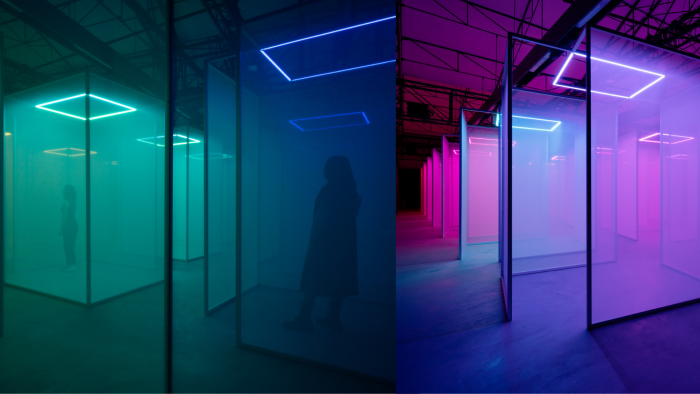
Visitors are encouraged to engage with the space in various ways—standing, sitting, walking, closing their eyes, or even lying on the floor. Their time, their silence, is gently claimed for fifteen to twenty minutes. Here, there's no urgency of smartphones or external distractions; it's a moment for pure sensory experience—feeling, listening, and seeing. As the sound frequencies reverberate and the lights transform, enveloping them in a symphony of colors, visitors are brought back to their own presence, to their bodies. Through this immersive journey, Google aims to synchronize their senses, allowing them to perceive and comprehend the significance of color in a profound manner.
GIO PONTI – Villa Planchart Exhibition
Saint Laurent Rive Droite’s pavilion within the cloisters of San Simpliciano pays homage to Gio Ponti’s iconic modernist architecture in Caracas. Curated by creative director Anthony Vaccarello for Milan Design Week 2024, the exhibition presents a bespoke tableware collection originally conceptualized by the renowned Italian architect and designer in 1953 for the Villa Planchart in Venezuela, alongside an assortment of archival materials.
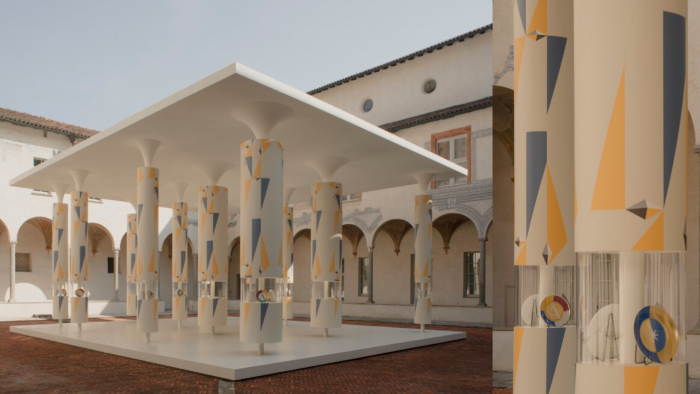
In partnership with Ginori 1735, Saint Laurent reintroduces twelve original plates from the Villa Planchart Segnaposto collection. Utilizing traditional craftsmanship techniques and adorned with motifs reminiscent of Ponti’s architectural style, these ornate porcelain plates are meticulously hand-painted at Ginori 1735’s Italian facility, preserving the essence of Ponti’s visionary design.
The Pattern of Dreams - Porsche
Design collective Numen/For Use has crafted a netted installation for Porsche's The Art of Dreams showcase at Milan Design Week, alongside a Vitra furniture collection. Drawing inspiration from Porsche's iconic "Pepita" pattern in black and white houndstooth, the installation explores themes of geometry, symmetry, rhythm, and repetition, reflecting the aesthetic cues of the automotive brand.
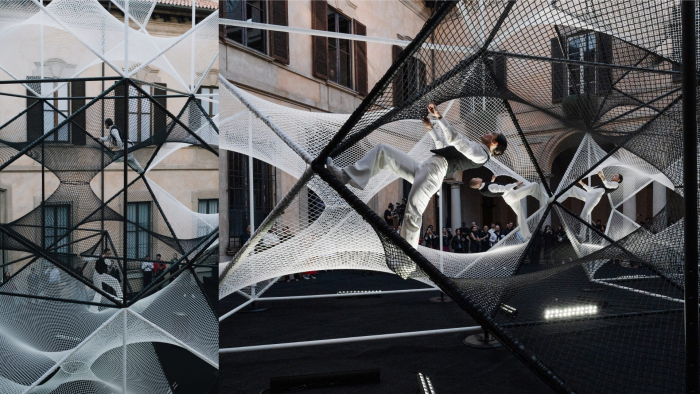
Installed within the courtyards of Palazzo Clerici in Milan, the colossal black and white netted structure dominates the space. Numen/For Use envisions their creation as an inhabitable utopia, viewing dreaming as a journey of self-discovery where the unfamiliar meets the novel. The monochromatic diagonals within the Pepita pattern evoke imagery of a flurry of starlings dispersing from a binary black and white matrix.
The pepita pattern, characterized by small interconnected squares and diagonal stripes, debuted in Porsche's 1948 model, the 356 C, and continued into the iconic 911 series. An original bright red 356 model is prominently displayed on a pedestal at The Art of Dreams exhibition. Numen/For Use's lightweight structure is constructed from delicate cells and contrasting single-color nets, adding a dynamic visual element to the showcase.
Re/Creation - Lasvit
The first sight to behold at Lasvit’s exhibition for Milan Design Week 2024 is a grand outdoor installation crafted from fused glass. Positioned in the courtyard of Palazzo Isimbardi, the installation, titled ‘Re/Creation,’ capitalizes on the unique properties of glass, serving as the primary material for the project. Lasvit showcases the fascinating results achieved by allowing extremely hot melted glass to naturally relax and spread, taking on the shape or form of the surface or object upon which it rests.
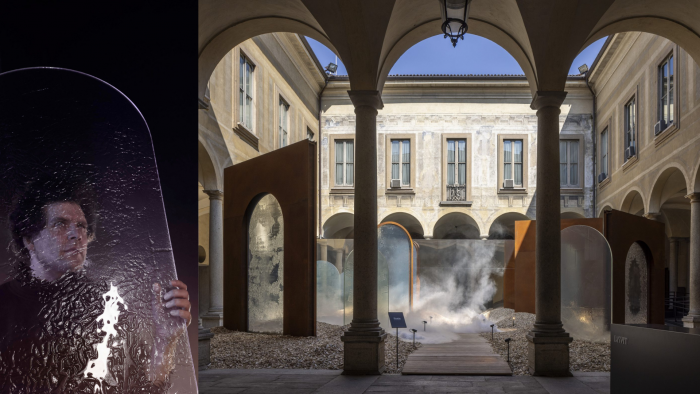
This outdoor spectacle is accompanied by another creation, conceived by Lasvit’s Art Director Maxim Velcovsky, who aims to highlight the symbiotic relationship between glass and architecture. Named Porta, this monumental piece emphasizes Lasvit’s expertise in artisanal glass facades, offering visitors a multifaceted view of fused glass. Crafted in Europe’s largest glass kiln, this installation exemplifies how the brand adapts to the scale and variability of glass while meeting the demands of architectural endeavors.
The Fireplace - Francis Kéré
Burkinabè architect Diébédo Francis Kéré has crafted a circular pavilion constructed from spruce logs for the German kitchen brand Next125, currently on display at Superstudio for Milan Design Week. Dubbed "The Fireplace," the pavilion is designed to investigate the idea of the kitchen as a space for communal gathering and sharing, evident in its rounded form and centralized kitchen unit.
Kéré explains, "Circularity embodies the democratic notion of gathering around the fire, akin to our ancestors' tradition of congregating around the fireplace." He elaborates, "The fireplace symbolizes the focal point where we unite and convene around the fire. In contemporary terms, the kitchen embodies this modern fire."
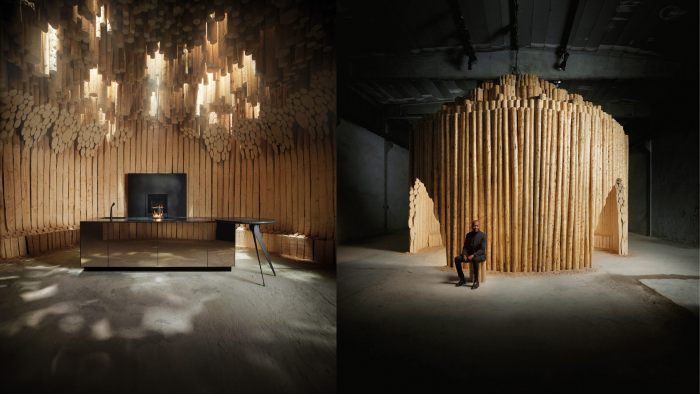
Contrasting a "modern sophisticated kitchen" with the "archaic" wooden shelter, the pavilion features a sleek kitchen island from Next125's collection at its center. The island boasts mirrored units topped with a marbled surface, exuding a contemporary aesthetic. Integrated into the wooden structure behind the island is a matching fridge unit, serving as a backdrop. Additionally, a circular table, supported by two metal legs, extends from the island, providing an additional communal surface for shared activities.
Formation 02 Toilet - Samuel Ross
Designer Samuel Ross aimed to challenge conventional notions of toilet design with his inaugural creation for bathroom brand Kohler, slated to debut at Milan Design Week. The Formation 02 smart toilet, boldly rendered in attention-grabbing orange, features an asymmetric shape inspired by the stark lines and angles of brutalist architecture.
Encircling the porcelain bowl is a shell crafted from composite resin, boasting unexpected cut-outs and textured sections reminiscent of natural rock formations. Produced in a limited edition, Formation 02 seeks to transform the humble toilet into a "functional sculpture."
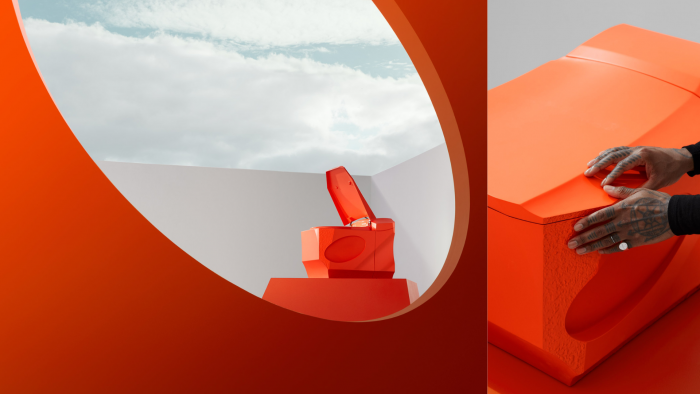 Furthermore, Formation 02 introduces a new pricing tier for such a product, retailing at approximately $25,000 per unit. This positioning places it in a fascinating intersection within contemporary design, straddling the boundary between object and artifact, and blurring the lines between design and functionality.
Furthermore, Formation 02 introduces a new pricing tier for such a product, retailing at approximately $25,000 per unit. This positioning places it in a fascinating intersection within contemporary design, straddling the boundary between object and artifact, and blurring the lines between design and functionality.